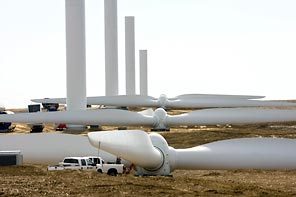forum
library
tutorial
contact

Growing Energy Field
Creates a Windfall of Opportunity
by Isolde RafteryThe Seattle Times, July 27, 2008
|
the film forum library tutorial contact |

|
Growing Energy Field
by Isolde Raftery |
 WASCO, Ore. -- Oskar Villalobos was tired of telling people he worked at Les Schwab.
WASCO, Ore. -- Oskar Villalobos was tired of telling people he worked at Les Schwab.
He wanted a job that sounded more impressive and paid better. Part of him dreamed of making a global impact.
So when he read about the renewable-energy-training program at Columbia Gorge College in The Dalles, he signed up. And after graduating from the six-month pilot program, he landed a job at the Biglow Canyon wind farm as a technician.
Now Villalobos is a hot commodity. Several other wind-energy companies have offered him plum assignments. The industry has become so competitive in the Pacific Northwest that he's not allowed to divulge what he earns.
(Industrywide, wages range from $16 to $25 an hour.)
"It's growing so darn fast, they can't get enough techs out in the field," said Columbia Gorge instructor Alan Bailey. The school is the only West Coast community college with a wind-technician program.
Wind energy started booming in the Columbia Gorge several years ago, giving an otherwise economically depressed area a glimmer of hope. The timber industry tanked about 15 years ago, and the demise of an aluminum smelter took 600 jobs.
The federal government's goal is to generate 15 percent of its electricity from wind -- a clean, renewable source -- by 2020. The U.S. Department of Energy announced that it would be reasonable to expect 20 percent by 2030, a mark set by Denmark and Germany.
Currently, about 1 percent of energy nationwide comes from wind turbines. Washington is ranked fifth in the country for wind energy produced, but only 24th for long-term potential by the American Wind Energy Association.
The wind rush, as some call it, may bring 500 to 600 wind-technician jobs into an area with a work force about 100 times that, according to Employment Security Department economist Scott Bailey.
It's dangerous work, said Villalobos, who has since become a safety coordinator. The techs climb up to 360 feet and crawl into a hub. They're harnessed in and work with a partner, often troubleshooting on a laptop.
"If you're up there, you're always thinking something could happen," he said.
Climbing to the top is worth it. It took Villalobos two tries before he felt confident scrambling up six turbine towers a day. Now he looks out across thousands of acres of wheat fields and at snow-capped Mount Hood. He sees blades dipping majestically, spinning shadows against the landscape.
Up close they're terrifying: Each blade looks like a beluga whale continually lifting and dipping. They work the same way as coal or hydroelectric power, by rotating a generator that then pushes a wire through a magnetic field to create electricity.
Wind energy has spun off its own industries, too.
Recent graduate Elizabeth Kokos, 45, a trucker-turned-technician, said her trucker husband has thought about hauling turbine parts.
Wheat farmers benefit because the energy companies pay them annual royalties for the space, at about $10,000 per turbine.
Money has been pumped into the Port of Vancouver, where all the turbine parts arrive from Denmark, Spain or Asia. The port purchased a large crane because of the booming business and got permission in May to buy another.
Last year, 26 more full-time longshoremen were hired to work at the port, also because of wind energy.
Booms end in busts, but it appears that wind energy won't peak for some time.
After all, the Columbia River Gorge boasts the space to quintuple its generating capacity.
learn more on topics covered in the film
see the video
read the script
learn the songs
discussion forum
